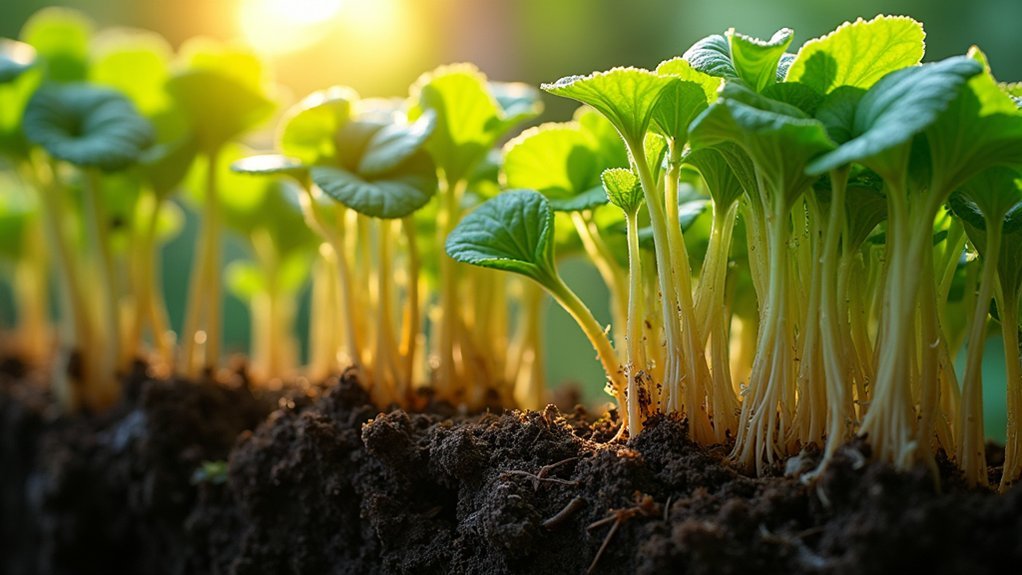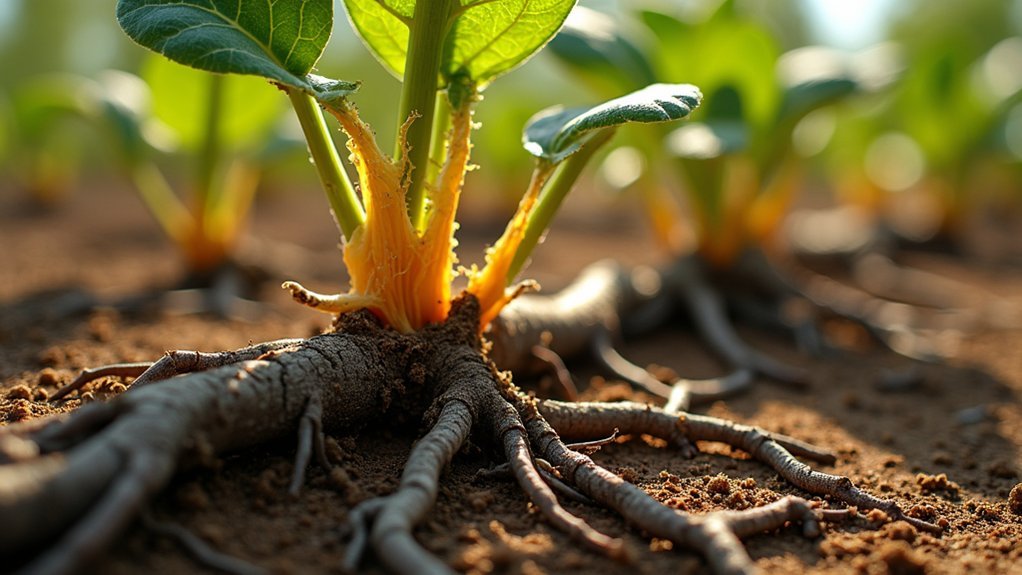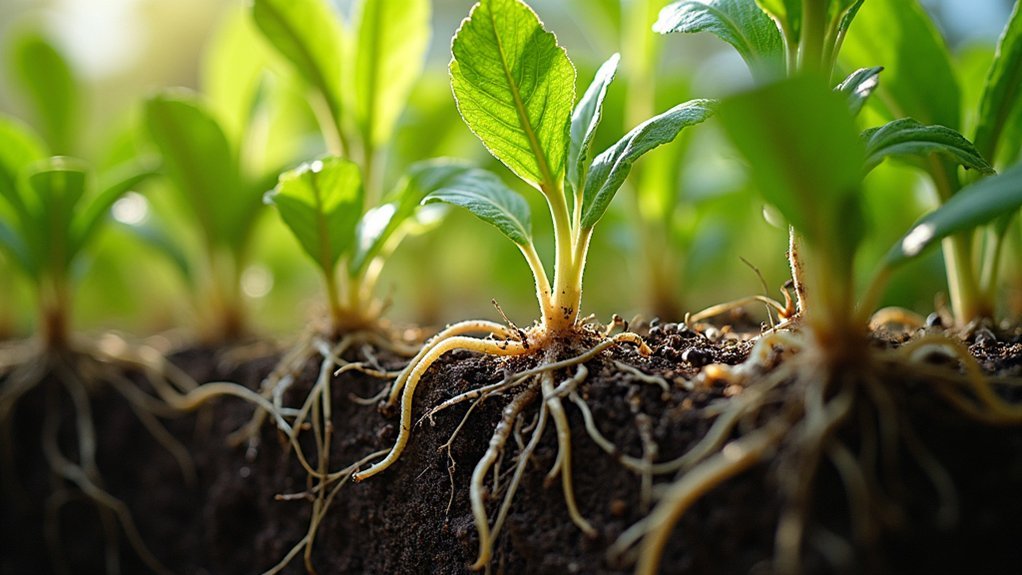Mycorrhizal fungi dramatically strengthen your natural fence roots in seven key ways: they expand root surface area by 1000x, enhance nutrient absorption, improve soil structure, increase drought resistance, protect against pathogens, enable plant communication, and accelerate growth establishment. These beneficial fungi create an underground network that transforms ordinary fence plants into resilient living barriers with superior stability and longevity. Discover how this powerful symbiotic relationship creates virtually impenetrable property boundaries even in challenging conditions.
Enhanced Nutrient Absorption for Fence Plants

When establishing natural fences, you’ll discover that mycorrhizal fungi serve as invisible allies for your fence plants. These remarkable fungi can expand your plants’ root surface area by up to 1000 times, dramatically improving their nutrient-gathering capabilities.
Mycorrhizal fungi help your fence plants access essential nutrients like phosphorus and nitrogen that would otherwise remain unavailable. The symbiotic relationship formed between these fungi and plant roots creates an enhanced nutrient absorption system that’s particularly valuable during challenging conditions like drought.
Invisible partners empowering your fence plants to thrive by unlocking nutrients that would otherwise remain forever out of reach.
You’ll find that fence plants with mycorrhizal associations maintain better vigor and establish more quickly. The fungi simultaneously improve soil structure around your fence plants, creating better aeration and water retention.
This extensive support system guarantees your natural fence develops stronger, more resilient roots even in less-than-ideal soil conditions.
Expanded Root Systems for Greater Stability
Beyond nutrient absorption, mycorrhizal relationships dramatically enhance the physical stability of your natural fence plants. When you introduce these beneficial fungi to your fence line, they can expand root surface area up to 1000 times, creating a more extensive and robust root system.
The mycorrhizal network strengthens root structural integrity, making your fence plants more resilient against environmental stressors and soil erosion. These fungi secrete glomalin, which improves soil aggregation and water retention, supporting deeper root growth and better anchorage.
You’ll notice your natural fence developing stronger stability as the mycorrhizal fungi help your plants access essential nutrients like phosphorus and iron. This symbiotic relationship guarantees your living fence maintains firm ground contact, providing the reliable barrier you need while withstanding challenging conditions.
Drought Resistance in Natural Living Fences

Mycorrhizal fungi transform your natural living fence’s drought resistance by creating extensive water access networks that connect multiple plants through underground highways.
You’ll notice improved survival rates during dry periods as these fungal partners extend your fence plants’ root zones far beyond what they could achieve alone.
Your fence’s enhanced ability to access deep water sources and share resources among plants creates a resilient barrier that withstands even prolonged drought conditions.
Water Access Networks
Although rarely visible to the naked eye, the interconnected underground networks formed by mycorrhizal fungi serve as essential lifelines for natural living fences during drought conditions.
These networks dramatically increase your plants’ root surface area through mycorrhizal colonization, enabling them to access water sources that would otherwise remain out of reach.
You’ll find these fungi create extensive underground highways that allow neighboring trees and shrubs to share water resources. This collaborative system improves drought resistance throughout your entire living fence.
The fungi also secrete glomalin, a remarkable protein that enhances soil structure and water retention while reducing evaporation.
Root Zone Expansion
When your living fence plants partner with mycorrhizal fungi, they develop a markedly expanded root zone that serves as their primary defense against drought conditions.
These beneficial fungi increase root surface area up to 1000 times, allowing your fence plants to access water and nutrients far beyond their normal reach.
This extensive network creates connections between multiple roots, enabling your fence plants to share moisture even during dry periods.
The fungi also facilitate uptake of critical nutrients like phosphorus and iron—elements that help plants withstand water scarcity.
You’ll notice improved soil structure around your living fence as mycorrhizal associations develop, enhancing water retention and reducing erosion.
This underground communication network allows your fence plants to share resources collectively, building resilience against drought that individual plants couldn’t achieve alone.
Protection Against Soil-Borne Pathogens
Your living fence’s defense system gets a major upgrade when mycorrhizal fungi create protective barriers around roots that block harmful pathogens.
These fungal networks boost your plants’ immune response by improving nutrient uptake, especially phosphorus and iron—key elements for fighting disease.
Mycorrhizae also actively compete with soil-borne pathogens for space and resources, creating an environment where your fence roots can thrive despite potential threats.
Disease Barrier Formation
While plants appear to stand alone in their battle against pathogens, they’re actually protected by an invisible shield formed through mycorrhizal partnerships. These fungi create a physical barrier around your fence plants’ roots, blocking harmful pathogens from penetrating vulnerable tissues.
| Mycorrhizal Protection Mechanism | Benefit to Plant Health |
|---|---|
| Physical root sheathing | Blocks pathogen entry points |
| Enhanced immune signaling | Triggers defensive responses |
| Improved phosphorus uptake | Strengthens overall resilience |
| Competitive exclusion | Reduces pathogen colonization |
| Beneficial microbiome support | Creates hostile environment for pathogens |
You’ll notice healthier fence plants when mycorrhizal fungi are present because they’re not just passive protectors—they actively strengthen your plants’ natural defense systems. This living barrier transforms the root zone into a fortress, making your natural fence more disease-resistant and robust.
Root Immunity Enhancement
Beneath the soil’s surface, mycorrhizal fungi transform plant roots into sophisticated immune centers that actively combat soil-borne pathogens.
When you introduce these fungi to your natural fence, they create protective shields around root systems, blocking harmful organisms from making contact with vulnerable plant tissues.
These fungal partners don’t just form physical barriers—they’re actively secreting antimicrobial compounds that inhibit pathogen growth.
You’ll notice plants with mycorrhizal associations show considerably fewer disease symptoms than their unprotected counterparts.
Your fence’s root immunity benefits further as mycorrhizal fungi improve the surrounding soil microbiome, encouraging beneficial microbial communities that offer additional protection.
This enhanced nutrient acquisition strengthens overall plant vigor, enabling your fence’s roots to better withstand both pathogenic threats and environmental stressors that might otherwise compromise their health.
Pathogen Competition Mechanisms
Mycorrhizal fungi actively engage in sophisticated competition with pathogens to protect your natural fence roots. They create a physical barrier by forming a protective web around root systems, effectively blocking soil-borne pathogens from making contact with vulnerable plant tissues.
You’ll find these beneficial fungi stimulate increased production of root exudates that naturally inhibit harmful microorganisms. They also compete directly with pathogens for essential nutrients and space in the rhizosphere, preventing pathogen establishment before infection can occur.
As mycorrhizae colonize your fence plants’ roots, they trigger enhanced production of antimicrobial compounds within the plant itself.
This multi-layered defense system, combined with improved overall plant vigor through better nutrient uptake, creates a resilient root system that’s considerably more resistant to disease pressures.
Improved Soil Structure Around Fence Lines
As landowners install natural fencing, they’re often unaware of the remarkable underground partnerships taking place. Mycorrhizal fungi actively transform the soil structure around your fence lines, secreting glomalin that binds soil particles into stable aggregates. This improves aeration and creates a more supportive environment for your fence roots.
The hidden fungal networks beneath your natural fence create soil architecture that supports and nourishes your living boundary.
You’ll notice better water infiltration as the fungi’s hyphal networks form tunnels through compacted areas, allowing your natural fence to develop stronger root systems.
These fungal allies also increase microbial biomass, enhancing nutrient cycling that delivers essential phosphorus and nitrogen to your fence vegetation. By stabilizing the soil, mycorrhizae prevent erosion during heavy rains while strengthening your fence line’s resilience against environmental stressors like drought and wind.
This underground support system guarantees your natural fencing remains sturdy and healthy year-round.
Accelerated Growth and Establishment

When you introduce mycorrhizal fungi to your natural fence plantings, you’ll witness dramatically faster establishment rates than conventional methods allow. This acceleration occurs because arbuscular mycorrhizal fungi effectively extend your plants’ root systems by up to 1000 times, enabling faster nutrient and water absorption.
You’ll see particularly impressive phosphorus uptake, which directly contributes to accelerated growth of robust root structures.
As your living fence develops, the mycorrhizal network creates a communication highway between plants, allowing them to share resources and respond more effectively to environmental stresses.
By inoculating your soil before planting, you’re fundamentally giving your fence a head start—plants establish more quickly with improved vigor and resilience.
This acceleration means your natural fence will reach functional maturity months or even years sooner than untreated plantings.
Natural Communication Between Fence Plants
The intricate underground “wood wide web” formed by mycorrhizal fungi serves as a sophisticated communication system for your natural fence plants.
These fungi create extensive networks connecting plant roots, allowing them to share information about environmental threats like insect attacks.
When one plant detects danger, it can signal others through this fungal network, triggering defensive responses throughout your living fence.
You’ll notice improved collective resilience as fence plants warn each other and respond together to stresses.
These mycorrhizal connections expand root surface area by up to 1000 times, enhancing both nutrient exchange and communication capabilities.
Your fence plants fundamentally function as a community rather than individual specimens, supporting each other during drought or other challenging conditions, creating a stronger, more unified barrier.
Frequently Asked Questions
How Does Mycorrhizae Help Roots?
Mycorrhizae help your plant roots by dramatically increasing surface area, enhancing nutrient absorption, improving soil structure, boosting drought resistance, and creating beneficial networks that share resources between plants in your garden.
What Are the Disadvantages of Mycorrhizae?
While mycorrhizae offer many benefits, you’ll find they’re vulnerable to high fertilizer levels, fungicide applications, and soil disturbances. They can also become ineffective in compacted or saline soils and may disappear during non-mycorrhizal crop rotations.
Can You Use Too Much Mycorrhizae?
Yes, you can use too much mycorrhizae. You’ll risk fungal competition, nutrient imbalances, and suppression of beneficial effects. It’s better to follow recommended application rates and monitor your plants’ response after inoculation.
Does Mycorrhizae Help With Root Rot?
Yes, mycorrhizae does help with root rot. You’ll find these fungi protect your plants by improving nutrient uptake, forming protective barriers against pathogens, and enhancing soil structure to prevent the waterlogged conditions that cause rot.
When Not to Use Mycorrhizal Fungi?
Don’t use mycorrhizal fungi after applying fungicides, in soils with high soluble nutrients, in newly tilled areas, during environmental stress like drought or flooding, or with non-mycorrhizal crops. They’ll be ineffective in these conditions.
In Summary
When you add mycorrhizae to your living fence project, you’re giving those plants a massive advantage. They’ll develop stronger roots, resist drought, ward off disease, and communicate more effectively with neighboring plants. Your fence won’t just grow faster—it’ll establish a resilient foundation that strengthens over time. By harnessing this natural fungal partnership, you’re creating a boundary that’s both beautiful and remarkably durable.





Leave a Reply